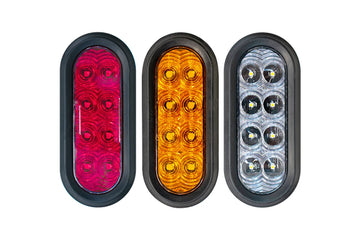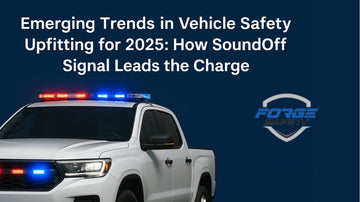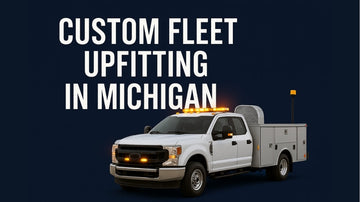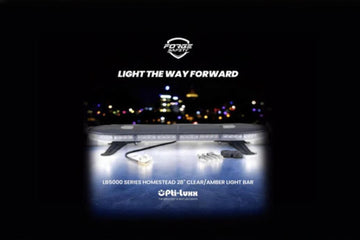Emergency vehicle lights are an important part of road safety. But have you ever wondered why certain colors are used or how different light patterns help in specific emergencies? The science behind emergency vehicle lights goes beyond just flashing colors they’re designed to be noticed, understood, and acted upon quickly.
This blog will explore everything you need to know, from the different light types to the best practices for their usage.
The Different Types of Emergency Vehicle Lights
Emergency vehicle lights come in various forms, each designed to fulfill specific needs during an emergency. Here’s a breakdown of the most common types of emergency vehicle lights: [1]

1. Light Bars
Lightbars are one of the most recognizable types of emergency vehicle lights, often seen atop police cars, ambulances, and fire trucks. They provide 360-degree visibility, allowing them to be seen from all directions, which is important in emergencies.
Lightbars come in various sizes and configurations, from compact mini lightbars for smaller vehicles to large full-size units for larger trucks. They often feature multiple flashing patterns and can combine different colors (e.g., red, blue, and amber) for maximum visibility.
2. Grille Lights
Grille lights are smaller, but highly effective emergency lights are installed in the front grille of vehicles. Compact yet powerful, these lights add an extra layer of visibility, especially in situations where low-profile lighting is needed. Grille lights are a favorite for law enforcement and first responders as they are unobtrusive but highly noticeable when activated.
Mounted in the vehicle’s front, they catch the attention of oncoming drivers, providing a clear indication to yield. Grille lights are perfect for responders who need additional front-facing visibility without large or bulky setups.
3. Warning Strobes
Warning strobes are used in a combo with other lighting types to enhance visibility, especially in low visibility situations like fog, rain, or smoke.
These lights emit intense, rapidly flashing bursts of light, which are highly effective at grabbing attention from a distance. Emergency vehicles like fire trucks and ambulance response vehicles frequently use warning strobes to alert other drivers to their presence.
4. Beacons and Rotators
Beacons and rotating lights, often seen on tow trucks or construction vehicles, are designed to provide constant, 360-degree warning signals. Rotating beacons typically have a light that spins around, creating a sweeping effect that can be seen from all angles. These lights are particularly useful in nonemergency vehicles that still need to signal potential road hazards, such as roadwork or accident sites. [2]
What Does Each Color Code Mean?
The colors of emergency vehicle lights aren't just random; they each serve a specific purpose. Understanding these colors can help you react appropriately when you’re on the road and see flashing lights in your rearview mirror. Let's break down the most common light colors and why they matter. [3]
1. Red
Red lights are probably the most well-known, typically associated with ambulances, fire trucks, and other life-saving emergency vehicles. The bright red flashes signal that something urgent is happening whether it's a medical emergency or a fire.
When you see red lights, it's a clear sign that you need to pull over and give way to ensure the vehicle can reach its destination as quickly as possible. These lights are used because red is the color that is most visible in low light conditions, making it effective at grabbing attention, even from a distance.
2. Blue
Blue lights are used for law enforcement. Whether it’s a police car on a chase or an officer directing traffic, blue lights mean authority is on the scene. The combination of red and blue lights, often seen together on police vehicles, is a powerful attention grabber.
It’s a sign that something important is happening, perhaps a traffic stop, a pursuit, or the need for other drivers to move aside to allow police to get to a scene quickly. The blue color shows that something is against the natural surroundings, helping officers be more visible, even in the night.
3. Yellow
Amber or yellow lights aren't as urgent as red or blue lights, but they are also important for safety. These yellow flashing lights serve as a warning telling drivers to slow down and be cautious.
When you see amber lights, it’s a reminder that there could be something blocking the road, workers in the area, or potential hazards ahead. Amber is a color that is associated with caution and is meant to alert drivers to be more aware of their surroundings.
4. Green
You might not see green lights as often, but they’re used by volunteer responders in some areas. These green lights typically indicate that the person is not part of the regular emergency response team but is still on their way to help out in an emergency.
Green lights help these volunteers move quickly without confusing them with more urgent lights like red or blue.
5. White
White lights aren’t typically used alone in emergencies, but they play a crucial role. They are often used to illuminate the area around emergency vehicles, providing better visibility for responders in dark or complex environments.
Whether it's shining light on a crash scene or helping rescue teams navigate through rough terrain, white lights make sure that everyone can see what’s happening and act accordingly.
When and Where Emergency Vehicle Lights Should Be Used
Knowing when and where to use them is important for ensuring proper operation and compliance with the law. [4]

- Responding to emergencies: Ambulances, fire trucks, and police cars should activate their lights when called to an emergency, such as medical incidents, fires, accidents, or criminal activity.
- Traffic control and scene management: Emergency lights should be used to mark accident scenes, construction zones, or road hazards to warn drivers and maintain traffic flow safely around the area.
- High-priority situations: When officers or responders attempt to make an urgent stop, enforce traffic laws, or assist in critical situations, activating lights ensures others see them and can carry out their duties safely.
Emergency lights must be used strategically to ensure maximum safety, such as;
- On public roads: Lights should be used while responding to or working at accident scenes, during traffic stops, or when vehicles are traveling through areas with heavy traffic or low visibility.
- In work zones: Road maintenance vehicles, tow trucks, or construction vehicles should use amber or yellow lights to warn drivers of potential hazards, such as workers on the road or temporary changes in traffic patterns.
- At emergency response sites: Whether at fire scenes, medical emergencies, or law enforcement actions, lights should be used to establish a visible, safe perimeter.
Key Features to Consider When Choosing Emergency Vehicle Lights
When selecting emergency vehicle lights ensure they meet both operational and legal requirements:
- The lights should be powerful enough to be visible from a distance, especially in low light or adverse weather conditions. Look for high-intensity LEDs that offer bright, clear visibility.
- Emergency lights are exposed to harsh conditions. Choose lights with an IP (Ingress Protection) rating to ensure they are water, dust, and shock resistant.
- Lights should be easy to mount and securely fitted on the vehicle. Consider options with adjustable brackets or suction mounts for flexible installation.
- Check local regulations regarding light color, flashing patterns, and placement to ensure compliance.
- LED lights are energy efficient, lasting longer and consuming less power than traditional incandescent bulbs, which is crucial for maintaining vehicle battery life during extended emergency responses.
How to Maintain Emergency Vehicle Lights
Proper maintenance is important for optimal performance:

- Clean lights regularly to remove dirt and grime that could obscure light output. Use a soft cloth and mild detergent.
- Periodically inspect lights for cracks, water damage, or loose connections. Replace damaged lights immediately.
- Ensure all lights are securely mounted to prevent vibrations that may cause wiring issues or light failure.
- Regularly test light functionality, including flashing patterns, to ensure they operate correctly when needed.
Final Words
Using the right emergency lights is crucial for ensuring road safety. By understanding these different types, colors, and features to consider, as well as the importance of proper maintenance, you can make informed decisions that keep responders visible and safe. Investing in high-quality lights and taking good care of them ensures they’ll perform when it matters most, helping save lives and prevent accidents.
Frequently Asked Questions
Who uses red and white emergency lights?
Ambulances and fire trucks typically use white and red lights to indicate an urgent emergency. The combination of white and red colors grabs attention and signals immediate action.
What do yellow and blue lights mean?
Blue lights are used by law enforcement to indicate police presence or action. Yellow or amber lights are used for caution, typically seen on tow trucks or construction vehicles to warn drivers of potential hazards.
Why are blue and red lights used in ambulances?
Red and blue lights are used in ambulances to signal urgency and authority, ensuring that other vehicles move out of the way quickly. The flashing pattern helps them stand out in traffic.
[1] https://forgesafetyvehicles.com/
[2] https://www.facebook.com/photo/?fbid=122147099762326559&set=pb.61559796778498.-2207520000
[3] https://www.instagram.com/p/DB1z7ZbM5_i/
[4] https://www.facebook.com/people/Forge-Safety/61559796778498/










